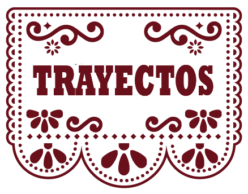Present tense of -er and -ir verbs: Uso y forma
Las actividades de Carolina
Do you remember Carolina? Today she is writing an email to a member of her family in México. ¿Cuáles son las actividades de Carolina? Read the email below, paying attention to the verbs in bold. What do you notice about the endings?
Hola, abuelita. ¿Cómo estás? ¡Espero que muy bien! La universidad es difícil, pero muy interesante. En general, los estudiantes asisten (attend) a clase todos los días. En mis clases, leo muchos libros y escribo muchos ejercicios y ensayos (essays). Bailey y yo aprendemos mucho sobre el español en los Estados Unidos en la clase de la Dra. Moyna. Extraño (I miss) mucho tus chilaquiles. Siempre como comida rápida. También corro 3 millas en el parque tres veces por semana…

¿Comprendiste? Responde estas preguntas sobre el email.
1. Let’s talk about verbs first. See if you can find an example of the following in the email:
Unos verbos conjugados:
- Verbs conjugated in first person singular (yo form):
- Verbs conjugated in first person plural (nosotros form):
- Verbs conjugated in third person plural (ellos form):
What do these verbs share? What do you already know about these verb endings?
2. Now let’s talk about the content of the email (continue paying attention to the verb endings):
- ¿A quién escribe Carolina?
- ¿Cuándo asisten a clase los estudiantes? Y tú, ¿cuándo asistes a clase?
- ¿Qué escribe Carolina en sus clases?
- ¿Qué comida come Carolina?
- ¿Cuántas millas corre Carolina? Y tú, ¿corres?
All the conjugated verbs that appear in the dialogue are in the present tense (el tiempo presente). In this section, we will learn how to conjugate verbs with the -er and -ir endings in the present tense. ¡Manos a la obra!
The Present Tense of –er and -ir Verbs
I. Infinitives and Conjugations
-er verbs: To conjugate, drop the –er from the infinitive. Next, add endings to the stem. The ending will depend on who is doing the action (remember the subject, discussed in Módulo introductorio). Have a look at this example:
| Comer (to eat) | ||
| yo | como | I eat |
| tú | comes | you (informal) eat |
| vos | comés | you (informal) eat; mostly Argentina & Uruguay |
| usted, él, ella | come | you (formal) eat, he/she eats |
| nosotros(as) | comemos | we eat |
| vosotros(as) | coméis | y’all (informal: Spain) eat |
| ustedes, ellos/ellos | comen | y’all eat, they eat |
-ir verbs: To conjugate, drop the –ir from the infinitive. Next, add endings to the stem. The ending will depend on who is doing the action (remember the subject, discussed in Módulo introductorio). Have a look at this example.
| Vivir (to live) | ||
| yo | vivo | I live |
| tú | vives | you (informal) live |
| vos | vivís | you (informal) eat; mostly Argentina & Uruguay |
| usted, él, ella | vive | you (formal) live, he/she lives |
| nosotros(as) | vivimos | we live |
| vosotros(as) | vivís | y’all (informal: Spain) live |
| ustedes, ellos/ellos | viven | y’all live, they live |
| aprender | to learn |
| asistir | to attend |
| beber | to drink |
| compartir | to share |
| correr | to run |
| escribir | to write |
| imprimir | to print |
| leer | to read |
| ver | to see/watch |
| vender | to sell |
| vivir | to live |
The following video summarizes the information discussed in this section, and it reviews what we already know about -ar verbs.
![]() Presente regular en español
Presente regular en español
Attribution: Presente regular en español – Spanish Regular Verbs in Present Tense. By ProfeDeELE.es, licensed under CC BY 3.0.
Ahora usamos nuestros verbos nuevos. ¡A trabajar! Actividad 2-15. Go to this website (http://bit.ly/ActividadPresente), and do Actividad 4: Completar. Take down notes to discuss your work in class. Actividad 2-16. Un correo electrónico Remember Dylan? He is writing an email to introduce himself to his future host family in Guanajuato, Mexico. He needs some help! Complete the following paragraph with the appropriate forms of the verbs in parenthesis. Estimada Sra. Salazar: Me llamo Dylan. Soy estudiante universitario en Tejas. Yo 1. ___________________ (aprender) mucho español este semestre y 2. ___________________ (leer) muchos artículos sobre la cultura mexicana. Mis amigos y yo 3. ___________________ (asistir) a clases todos los días a excepción de los sábados y domingos. También mi mejor amigo, Francisco, y yo 4. ___________________ (trabajar) para una organización de ayuda (help) a inmigrantes hispanos. Los dos somos activistas y 5. ___________________ (compartir) muchas ideas! Los fines de semana, yo 6. ___________________ (visitar) a mi familia en Corpus Christi. Ellos 7. ___________________ (vivir) en una casa cerca del monumento El Mirador de la Flor. ¿Ustedes 8. ___________________ (escuchar) música de Selena? Mi canción favorita es Bidi Bidi Bom Bom. Los domingos, mi novio, Matt, y Mariana 9. ___________________ (beber) café en Starbucks y 10. ___________________ (comer) bagels allí también. Ellos son muy buenos amigos. 🙂 ¿Qué actividades 11. _____________(compartir) usted con su familia? Pronto yo 12. ___________________ (escribir) otro email. ¡Hasta pronto! Dylan Find a Google map of your city. Con un@ compañer@, habla de tus lugares favoritos to do the following activities. Take turns asking and answering questions. Don’t forget to point out the locations on the map. E1: ¿Dónde beben tú y tus amigos? E1: ¿Dónde comes/comés los fines de semana? Paso 1. You will need to ask and answer questions in Spanish (use the vocabulary and structures you have learned so far) to find out the following information: E1: ¿De dónde son tus padres? Paso 2. Write a summary of your results to present to the rest of the class. ¿Cuáles son las similitudes?![]() ¡Manos a la obra!
¡Manos a la obra!
![]() Actividad 2-17. ¿Dónde?
Actividad 2-17. ¿Dónde?
E2: Bebemos en Harry’s.
E2: Como en Napa Flats.
![]() Actividad 2-18. Las familias de la clase. Con tres o cuatros compañer@s, you will need to create a summary of the main characteristics that can be used to describe la familia tejana as represented by students’ families.
Actividad 2-18. Las familias de la clase. Con tres o cuatros compañer@s, you will need to create a summary of the main characteristics that can be used to describe la familia tejana as represented by students’ families.
E2: Son de Austin. ¿Y tus padres?
E1: Son de Lubbock.
Click on the following button to continue using your new verbs.
Ahora dejamos (we leave) nuestras ciudades (cities) por un momento y aprendemos sobre Colombia. ¿Dónde está Colombia?


